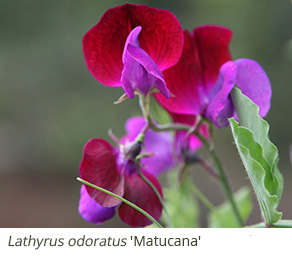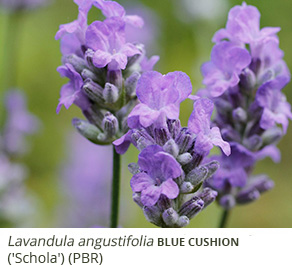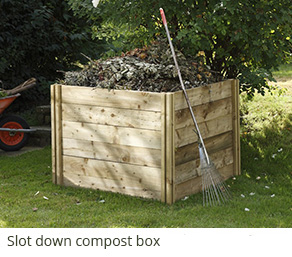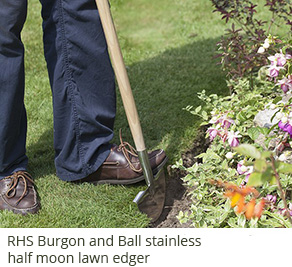Once you can feel the heat and the sun, it's a good time to plant some herbs because nothing’s so pleasurable as gathering up some leaves and stems to add to your favourite dishes. If you've got room make a dedicated herb garden or, if space is tight, make an edible container and place it close to a sunny doorway so you can cut and come again. An old wicker basket makes a good container. Mix the leafy textures, because most herbs have lots of leaf and rather insignificant flowers. Make sure you use chives, because the narrow, grassy foliage is good at bringing a scheme together. It adds contrast to all the other textures.
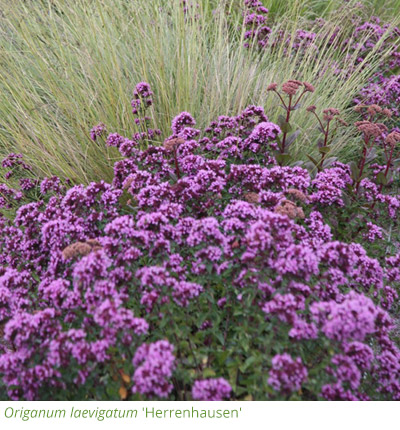 Aromatic herbs, the ones that smell pungent when you stroke the foliage, thrive in sunny, hot spots once they’re established. They develop deep root systems in time, but you will need to water them in their first growing season because they won’t have got their roots down into the depths of the ground. The oily covering on the foliage acts as the plant’s sunscreen and many also have silver foliage, a pale colour that absorbs far less heat. Aromatic herbs, the ones that smell pungent when you stroke the foliage, thrive in sunny, hot spots once they’re established. They develop deep root systems in time, but you will need to water them in their first growing season because they won’t have got their roots down into the depths of the ground. The oily covering on the foliage acts as the plant’s sunscreen and many also have silver foliage, a pale colour that absorbs far less heat.
Sometimes the foliage is covered in fine hairs, almost woolly to the touch, and others have finely divided foliage, needle-like leaves, or tiny leathery leaves. These are all devices for surviving summer sun, because most aromatic herbs come from the Mediterranean region. They tend to do most of their growing in winter in their native habitat, so most aromatic herbs need leaving intact over winter. They are trimmed back in the spring and this keeps them vigorous and compact. Don’t let them go leggy: it will shorten their lifespan.
Aromatic herbs tend to be very insect-friendly because their flowers produce highly concentrated nectar, far more sugar-packed than most flowers. The most concentrated nectar of all is exuded by marjoram so planting Origanum laevigatum 'Herrenhausen' will really pull in the butterflies and bees in August. The sprays of two-tone pink and purple flowers are a good addition to any sunny position, whether it's a herb garden or a flower border, and a lacy seed head follows.
Thyme is a classic herb often used with beef and it's a great herb for the front of the border. Thymes are members of the mint family and they take their name from the Greek word ‘thymon’ meaning courage. Roman soldiers were said to have rubbed the oil on before battle. One of the lowest growing is wooly thyme, Thymus polytrichus, and this creeping herb is grown for its soft green foliage rather than its pink flowers. It will creep over paving fairly quickly, but it hates wet ground and will often succumb in wet winters. Surround it with gravel if you intend to grow it in the ground.
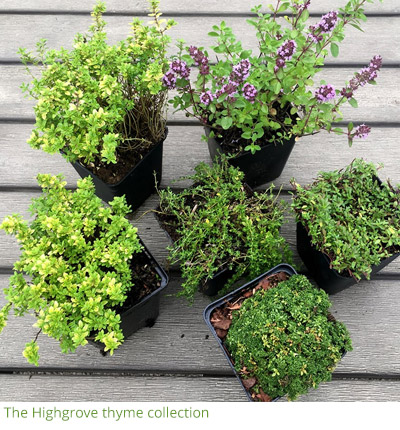 Thymes are often grown in paving and Prince Charles's Highgrove Garden used to have a thyme walkway. The Highgrove thyme collection contains six low-growing thymes and 20% of the proceeds are given to the Prince of Wales’s Charitable Foundation. When you walk across the paving in high summer the wonderful scent of thyme rises up to meet you and like many herbs make sensuous, relaxing plants whether your touching them, picking them or just treading on them. Thymes are often grown in paving and Prince Charles's Highgrove Garden used to have a thyme walkway. The Highgrove thyme collection contains six low-growing thymes and 20% of the proceeds are given to the Prince of Wales’s Charitable Foundation. When you walk across the paving in high summer the wonderful scent of thyme rises up to meet you and like many herbs make sensuous, relaxing plants whether your touching them, picking them or just treading on them.
If you want a good culinary thyme that will come back year on year, opt for common thyme (Thymus vulgaris), because this can be picked throughout the year. Once spring arrives, cut it back hard to keep it compact. Common thyme reaches between six and nine inches in height and it makes a pretty herb border edging. The foliage is a soft grey-green and the flowers are a cool pink.
You could also use the variegated ‘Silver Posie’, which has tiny green leaves edged in white topped by heads of pale pink flowers. It's a very decorative thyme, one I like to grow on sunny edges in the flower garden. The leaves are very good in chicken and fish dishes and I often raid it when I want to make parsley and thyme stuffing in the winter. The lemon variegated thyme (Thymus 'Lemon Variegated') can also be used in the kitchen, although it does have a sharper flavour.
If it's flower power you're after Thymus Coccineus Group gets smothered in vivid pink flowers in high summer. ‘Russetings’ and ‘Bressingham’ are equally flower-packed with masses of pink flowers.
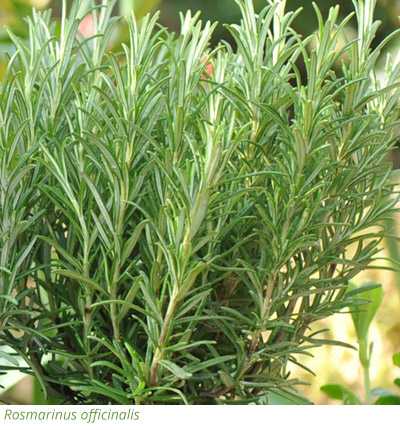 Other small-leaved herbs include rosemary and this forms a taller, woodier shape with stems clothed in needle-like leaves. Rosemary (Rosmarinus officinalis) is the classic accompaniment for roast lamb and it's very useful because it produces its blue flowers in spring, if it's in a sheltered position, so it can be a good, early bee plant. It's completely evergreen and provides a strong presence in winter. There are prostrate forms (Rosmarinus officinalis Prostratus Group) that creep over the ground and these are very useful in pots. Other small-leaved herbs include rosemary and this forms a taller, woodier shape with stems clothed in needle-like leaves. Rosemary (Rosmarinus officinalis) is the classic accompaniment for roast lamb and it's very useful because it produces its blue flowers in spring, if it's in a sheltered position, so it can be a good, early bee plant. It's completely evergreen and provides a strong presence in winter. There are prostrate forms (Rosmarinus officinalis Prostratus Group) that creep over the ground and these are very useful in pots.
The other winter classic is Sage (Salvia officinalis) and the grey green common sage will produce blue flowers by late summer. The purple-leaved sage (Salvia officinalis 'Purpurascens') is highly decorative and, if it's a hot summer, the foliage turns a deep plum colour setting off the mid blue flowers. This is almost too good just for herb gardens, because it shines in any summer spot and adds contrast among silver foliage. Both need a good trim in spring because the soft, almost-felty foliage tends to get ragged during winter.
Another sun loving herb, suitable for a sunny place, is tarragon, because this provides a nutty flavour when sprinkled over chicken. The best flavour comes from French tarragon (Artemisia dranunculus) and this often dies completely back in winter. It then shoots from the ground in May, as long as it is given a warm position, so it’s a good idea to mark where it’s planted. You almost certainly won't be able to pick a stem in winter, but it dries brilliantly and can be stored in airtight glass jars. French tarragon must be left undisturbed once planted, because it hates being divided.
Always grow bay (Laurus nobilis) if you can, although those with colder gardens may well need a large pot that can be placed somewhere very sheltered in winter. This handsome evergreen adds a savoury, deeper note to all stews and casseroles. Pick it fresh and add a leaf or two, or dry some leaves.
 Mints are equally useful in the kitchen, but many have a running habit that borders on the rampant so it’s better to grow them in pots unless you have bags of room. I couldn't do without Moroccan mint (Mentha spicata var. crispa 'Moroccan'), which is used to make a refreshing tisane. In Morocco, mint tea is always laced with lots of sugar and poured from a great height, but few things are as refreshing on a hot day. Brewing a cup in my garden on an English summer's day takes me straight back to the Medina. Even if you don't fancy the tea, this mint has highly crinkled, attractive green leaves. Mints are equally useful in the kitchen, but many have a running habit that borders on the rampant so it’s better to grow them in pots unless you have bags of room. I couldn't do without Moroccan mint (Mentha spicata var. crispa 'Moroccan'), which is used to make a refreshing tisane. In Morocco, mint tea is always laced with lots of sugar and poured from a great height, but few things are as refreshing on a hot day. Brewing a cup in my garden on an English summer's day takes me straight back to the Medina. Even if you don't fancy the tea, this mint has highly crinkled, attractive green leaves.
Apple mint (Mentha suaveolens) also has sumptuous foliage and it’s apple-scented. The bright green upper leaf is backed in silver, so it has a soft fuzzy look that sums up high summer.
It's equally rampant, so another candidate for a pot, or you can sink a bottomless large plastic pot in the ground and restrain it that way. If it escapes, it's likely to be easily removed. You can also try the darker leaved chocolate mint, Mentha × piperita f. citrata 'Chocolate' and this one has white flowers. Mints tolerate a wide variety of positions in the garden, and as they exhaust the ground they move on to a new spot.
Other herbs do best in shade and many of these are umbellifers, with rounded umbels of flower. Sweet Cicely (Myrrhis odorata) will perform in shade and the ferny, light-green leaves appear at the same time as rhubarb. If you add a couple of leaves to stewed rhubarb it gives it an aromatic flavour and cuts down on the amount of sugar needed, so it’s useful. The white, lacy flowers appear in summer and are followed by large black seeds, so this herb will self-seed and it can be a nuisance. Cutting the flowers off as they fade is an excellent idea.
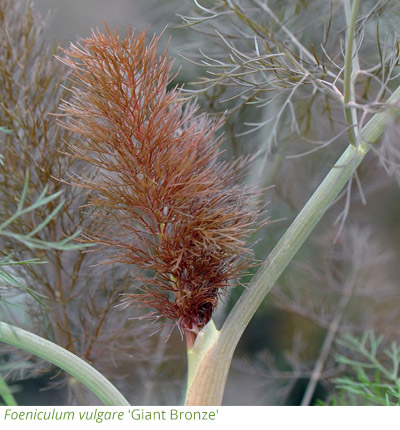 Bronze fennel (Foeniculum vulgare 'Giant Bronze') is another umbellifer, albeit a perennial one, and it can tolerate heavy soil and some shade. The smoky foliage appears in late spring and by the time the aquilegias are out, it has risen a couple of feet above the ground. The yellow umbels stand out well, although some gardeners remove them. It’s ornamental enough to be used in the herb garden, vegetable garden or flower border. When rain descends, it forms pearl drops on the wispy leaves. Bronze fennel (Foeniculum vulgare 'Giant Bronze') is another umbellifer, albeit a perennial one, and it can tolerate heavy soil and some shade. The smoky foliage appears in late spring and by the time the aquilegias are out, it has risen a couple of feet above the ground. The yellow umbels stand out well, although some gardeners remove them. It’s ornamental enough to be used in the herb garden, vegetable garden or flower border. When rain descends, it forms pearl drops on the wispy leaves.
Many umbelliferous herbs are annuals or biennials so they need replacing regularly. You can grow them from seed, but do remember that all umbellifers need warm temperatures in order to germinate. Parsley seeds should be grown in warm ground that has had warm water tipped over the surface. You can also sow dill, which is excellent with fish, and coriander in the same way and both will tolerate some shade. It's quicker to buy plants and bed them in, than to raise them from seed. Rocket will also do well in semi-shade and is far less prone to flea beetle if grown in a shady spot. Its peppery taste lifts a salad.
If you want to add some structure, use an Angelica and our native Angelica archangelica forms a strong green framework of stems topped by green roundels of flower. It loves a dank, wet corner so this man-high plant is often planted at the back of a herb garden. It will set copious numbers of seeds, so do cut it down after flowering.
|










